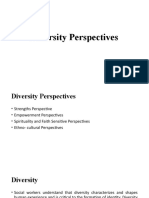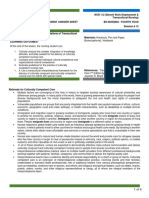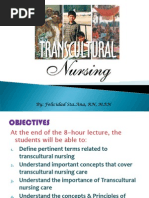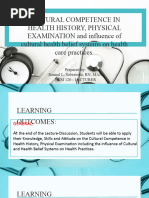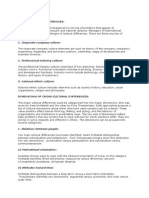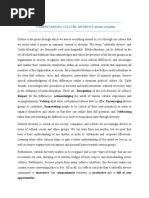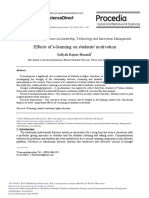0 ratings0% found this document useful (0 votes)
11 viewsCultural Diversity in The Health Care Workforce: By. Ns. Wulan Purnama
Cultural Diversity in The Health Care Workforce: By. Ns. Wulan Purnama
Uploaded by
eka peranduwinataThis document discusses cultural diversity in the health care workforce. It notes that the three most common employment settings for registered nurses in the US are hospitals, public health centers, and ambulatory care. It also discusses the challenges and opportunities posed by an increasingly multicultural population and workforce. Key aspects that can lead to conflicts include differing cultural perspectives on issues like family obligations, communication, time orientation, and gender roles. Effective management of a diverse workforce requires an understanding of these cultural differences.
Copyright:
© All Rights Reserved
Available Formats
Download as PPT, PDF, TXT or read online from Scribd
Cultural Diversity in The Health Care Workforce: By. Ns. Wulan Purnama
Cultural Diversity in The Health Care Workforce: By. Ns. Wulan Purnama
Uploaded by
eka peranduwinata0 ratings0% found this document useful (0 votes)
11 views21 pagesThis document discusses cultural diversity in the health care workforce. It notes that the three most common employment settings for registered nurses in the US are hospitals, public health centers, and ambulatory care. It also discusses the challenges and opportunities posed by an increasingly multicultural population and workforce. Key aspects that can lead to conflicts include differing cultural perspectives on issues like family obligations, communication, time orientation, and gender roles. Effective management of a diverse workforce requires an understanding of these cultural differences.
Original Description:
ppt
Original Title
Csf
Copyright
© © All Rights Reserved
Available Formats
PPT, PDF, TXT or read online from Scribd
Share this document
Did you find this document useful?
Is this content inappropriate?
This document discusses cultural diversity in the health care workforce. It notes that the three most common employment settings for registered nurses in the US are hospitals, public health centers, and ambulatory care. It also discusses the challenges and opportunities posed by an increasingly multicultural population and workforce. Key aspects that can lead to conflicts include differing cultural perspectives on issues like family obligations, communication, time orientation, and gender roles. Effective management of a diverse workforce requires an understanding of these cultural differences.
Copyright:
© All Rights Reserved
Available Formats
Download as PPT, PDF, TXT or read online from Scribd
Download as ppt, pdf, or txt
0 ratings0% found this document useful (0 votes)
11 views21 pagesCultural Diversity in The Health Care Workforce: By. Ns. Wulan Purnama
Cultural Diversity in The Health Care Workforce: By. Ns. Wulan Purnama
Uploaded by
eka peranduwinataThis document discusses cultural diversity in the health care workforce. It notes that the three most common employment settings for registered nurses in the US are hospitals, public health centers, and ambulatory care. It also discusses the challenges and opportunities posed by an increasingly multicultural population and workforce. Key aspects that can lead to conflicts include differing cultural perspectives on issues like family obligations, communication, time orientation, and gender roles. Effective management of a diverse workforce requires an understanding of these cultural differences.
Copyright:
© All Rights Reserved
Available Formats
Download as PPT, PDF, TXT or read online from Scribd
Download as ppt, pdf, or txt
You are on page 1of 21
CULTURAL DIVERSITY IN THE
HEALTH CARE WORKFORCE
By. Ns. WULAN PURNAMA
General Overview
The 3 most common employment settings for RN in the USA are
hospitals, public or community health centers, and ambulatory
care.
In many health care settings there is diversity in race, ethnicity,
religion, age, sexual orientation, and national origin.
Recent strides in the women movement have called attention to
important gender differences and the manner in which
changing societal roles of both men and women influence
relationships in the multicultural workplace.
The interrelationship between culture and the physical, mental,
and emotional handicaps and disabilities of some health care
workers must also be considered in the complex web called the
multicultural workforce.
The Challenges and Opportunities
of a Growing Multicultural Population
and Health Care Workforce
Because the health care workplace is a microcosm of
the changing demographic patterns in society at
large, the growing diversity among nurses and other
members of the health care team frequently poses
challenges and opportunities in the multicultural
work setting.
Transcultural Nursing Administration
It refers to a creative and knowledgeable process of assessing,
planning, and making decisions and policies that will facilitate
the provision of educational and clinical services that take into
account the cultural caring values, beliefs, symbols, references,
and life ways of people of diverse and similar cultures for
beneficial or satisfying outcomes (Leininger, 1996).
Contemporary, it focuses on cost-benefit outcomes, downsizing,
territorial struggles with members of other disciplines,
appropriate use of technology, and other important topics.
With the increasing diversity among members of the health
care workforce, nurses are challenged to develop and practice
a new kind of administration known as transcultural nursing
administration that positively influence cost-benefit and quality
outcomes.
Cultural Perspectives on the
Meaning of Work
Cultural norms influence a staff member’s consideration of
group interest as opposed to individual interest in the
multicultural workplace.
2 major orientations embraced by people: INDIVIDUALISM &
COLLECTIVISM.
Individualism: importance is placed on individual inputs, rights,
and rewards. Individualists emphasize values such as autonomy,
competitiveness, achievement, and self-sufficiency.
Collectivism: it entails the need to maintain group harmony
above the partisan interests of subgroups and individuals.
Collectivists emphasize values such as interpersonal harmony
and group solidarity prevail.
Individualists
They work to earn a living.
They don’t need to enjoy working.
They tend to dichotomize work and leisure.
Their concepts of work reflect an orientation toward
the future.
They are typically achievement oriented.
They want to do better, accomplish more, and take
responsibility for their actions.
They tend to develop personality traits such as
assertiveness and competitiveness that facilitate these
goals.
Collectivists
They value qualities such as commitment to
relationships, gentleness, cooperativeness, and
indirectness are valued.
They have sense of loyalty, commitment, and group
orientation, whereas the motivation of the managers
must appeal to the worker’s sense of contract, rules,
and individuality.
Corporate Cultures and Subcultures
Health care organizations are mini societies that have
their own distinctive patterns of culture and subculture.
Certain organization may have a high degree of
cohesiveness, with staff working together like
members of a single family toward the achievement
of common goals. Others may be highly fragmented,
divided into groups that think about the world in very
different ways or that have different aspirations
about what their organization should be. This
phenomenon is referred to as corporate culture.
Corporate Cultures…..
Corporate culture is a process of reality construction that allows
staff to see and understand particular events, actions, objects,
communications, or situations in distinctive ways.
It helps people cope with the situations they encounter and
provide a basis for making behavior sensible and meaningful.
The components: shared values, beliefs, meaning, and
understanding.
Social system is useful to distinguish between the organizational
climate of the work environment and the corporate culture.
Negative Attitudes and Behaviors in the
Multicultural Workplace
E.g. hatred, prejudice, bigotry, discrimination, racism, and violence.
Hatred is exacerbated during times of rapid immigration, periods of economic
recession or depression, and high unemployment (Henderson, 1994).
Prejudice refers to inaccurate perceptions of others. It results in conclusions that are
drawn without adequate knowledge or evidence.
Bigotry connotes narrow-mindedness and an obstinate or blind attachment to a
particular opinion or view-point.
Discrimination refers to behaviors and is defined as the act of setting one individual
or group apart from another, thereby showing a difference or favoritism.
Racism implies that superior or inferior traits and behavior are determined by race.
Race relations should be properly understood in the larger context of human
relations (Henderson, 1994).
Ethnoviolence is increasing by time, verbal threats and/or assaults by or against staff
members should not be tolerated.
Formation of Attitudes
When social amnesia develops, the individual tends to
create elaborate rationalizations in an effort to
account for learned attitudes toward certain groups
of people in a society.
The superiority or inferiority of a group (versus an
individual) is usually less obvious than an individual’s
behavior.
The values, behaviors, and customs of those in the
outgroup are labeled as “strange” or “unusual”.
Changing Attitudes
All the negative behaviors begin with an individual’s attitudes toward
certain groups.
Efforts to change staff member’s attitudes about people from culturally
diverse groups should center on communication.
Firstly, formal attitude change approach is based on learning theories on
the assumption that people are rational, information processing beings who
can be motivated to listen to a message, hear its content, and incorporate
what they have learned when it is advantageous to do so.
Secondly, groups dynamics approach assumes that staff members are social
beings who need culturally diverse coworkers as they adjust to
environmental changes.
Cultural Values in the
Multicultural Workplace
Values form the core of a culture.
Cultural values frequently lie at the root of cross-cultural differences in the
multicultural workplace.
Values affect people’s lives in 4 major ways: perceived needs, what is
defined as a problem, how conflict is resolved, and expectations of
behavior.
Time orientation, family obligations, communication patterns (including
etiquette, space/distance, touch), interpersonal relationships (including long-
standing historic rivalries), gender/sexual orientation, education,
socioeconomic status, moral/religious beliefs, hygiene, clothing, meaning of
work, and personal traits exert influences on individuals within the
multicultural health care setting.
Cultural Perspectives on Conflict
Conflict refers to actions that range from intellectual disagreement to
physical violence.
The actions that precipitates the conflict is based on different cultural
perceptions of the situation.
The dominant culture’s proverbs emphasize that people should behave
assertively and deal with conflict through direct confrontation.
Individualists view conflict as a healthy, natural, and inevitable components
of all relationships. Characteristic: assertiveness, confrontational, and direct
style of communicating.
Collectivists view conflict is not healthy, desirable, or constructive.
Mediation allows for saving face and is rooted in the realization that all
conflicts do not have simple solutions.
Cultural Origins of Conflict
Conflicting values that underlie problems:
1. Cultural perspectives on family obligations.
2. Personal hygiene.
3. Cross-cultural communication (etiquette and touch).
4. Clothing and accessories.
5. Time orientation.
6. Interpersonal relationships (long-standing historic rivalries
between groups; authority figures, peers, subordinates, and
patients).
7. Gender/sexual orientation.
8. Moral and religious beliefs.
Conflicting Role Expectations:
Staff Educated Abroad
Role is defined as the set of expectations and behaviors associated with a
specific position.
People from similar cultures are more readily able to relate to one another,
health care providers must be able to transcend cultural differences and to
recognize that there are differences in role expectations. Discrepancies in it
tend to create intrapersonal and interpersonal conflict.
Nurses have considerably expanded roles, and their scope of practices is
correspondingly broader.
Because of the shortage of qualified health care providers in many less
developed countries, there usually are fewer interdisciplinary differences
about the nature and scope of practice for various health care disciplines.
Cultural Assessment in the
Multicultural Workplace
1. Individual cultural self-assessment.
2. Cultural self-assessment of health care
organizations, institutions, and agencies.
Individual Cultural Self-Assessment
1. It focuses on staff members and their beliefs about multiculturalism in the
workplace.
2. It is important for nurses to be aware of their own ethnocentric tendencies.
This is best accomplished when individuals review their cultural attitudes, values,
beliefs, and practices.
3. By gathering responses to the individual cultural assessment instrument, nurse
managers can identify staff perceptions about diversity issues and determine
what management strategies might be useful.
4. A culturally diverse workforce should be a strength in meeting the needs of
culturally diverse patients and should be viewed as an asset.
5. Nurse managers need to release the cultural talents of this workforce.
Organizational Cultural Self-Assessment
Content and process are considered as important in
organizational self-assessment.
It is needed because of changing demographics in populations
served or concerns with quality of care for diverse patients.
The instrument may be used to assess an entire organization,
such as hospital, a long-term care facility, a home health
agency, or another organization, institution, or agency, or it
may be modified for the assessment of a particular unit or
division.
The Process…..
After identifying key staff members to lead the institutional cultural self-
assessment process, the leaders should communicate the purpose of the
cultural self-assessment to those who will be participating in it.
It is important to involve grassroots members of the staff and to solicit input
from the patient population served through interviews, focus groups, written
surveys, or other methods.
It involves collecting demographic and descriptive data, identifying
strengths and limitations, assessing the need and readiness for change,
identifying community resources, evaluating the effectiveness of changes,
and implementing any necessary revisions.
You might also like
- Diversity PerspectivesDocument25 pagesDiversity Perspectivescitylink set6pasig100% (2)
- Compilation TFNDocument65 pagesCompilation TFNEliakim III InsongNo ratings yet
- Cultural Diversity and NursingDocument21 pagesCultural Diversity and Nursingfatha86% (7)
- Adler - Interplay Chapter 02 - PPTDocument23 pagesAdler - Interplay Chapter 02 - PPTCassandraNo ratings yet
- My Ideal TeacherDocument1 pageMy Ideal Teachersirthana697547100% (1)
- On GerontionDocument6 pagesOn Gerontionnext.innovation8967No ratings yet
- Cross Cultural MCDocument12 pagesCross Cultural MCask123.grindeNo ratings yet
- Transcultural Perspectives in Nursing Administration: Author InformationDocument9 pagesTranscultural Perspectives in Nursing Administration: Author InformationawuahbohNo ratings yet
- Transcu AssignmentDocument9 pagesTranscu AssignmentCharles Gerard B. BeluanNo ratings yet
- Lecture One Definition of TermsDocument4 pagesLecture One Definition of Termssamuel chegeNo ratings yet
- Competency Based Organizational Culture PDFDocument9 pagesCompetency Based Organizational Culture PDFMonika ShindeyNo ratings yet
- Factors Influencing Health PromotionDocument5 pagesFactors Influencing Health PromotionHaniNo ratings yet
- Handout For Inclusiveness Modified by SNIE StaffsDocument61 pagesHandout For Inclusiveness Modified by SNIE Staffsasuasan151No ratings yet
- English - Intercultural CommunicationDocument12 pagesEnglish - Intercultural CommunicationAlexandra NevodarNo ratings yet
- Multicultural Hamdout 4,5&6Document12 pagesMulticultural Hamdout 4,5&6Arabella JuanilloNo ratings yet
- 04 Handout 1Document5 pages04 Handout 1Joana LirioNo ratings yet
- Transcultural Nursing in The 2Document19 pagesTranscultural Nursing in The 2mntzrzyd6No ratings yet
- A Report On Cultural DiversityDocument9 pagesA Report On Cultural Diversityguest096350% (2)
- Inbound 8920809902378357633Document8 pagesInbound 8920809902378357633yvonneangayonNo ratings yet
- Chapter 9 Nursing Celebrates Cultural DiversityDocument12 pagesChapter 9 Nursing Celebrates Cultural DiversityDon DxNo ratings yet
- Culture Health SocietyDocument27 pagesCulture Health Societymuhammad adilNo ratings yet
- Workforce DiversityDocument22 pagesWorkforce DiversityAnkita Saxena50% (2)
- Questionb.: Define Culture What Are Culture DimensionsDocument18 pagesQuestionb.: Define Culture What Are Culture DimensionszeshanNo ratings yet
- Culturally Competent Health CareDocument4 pagesCulturally Competent Health CareGwenn SalazarNo ratings yet
- Ethics AssighnmentDocument11 pagesEthics AssighnmentBetelhem TeferaNo ratings yet
- BMT-Hofstede S Cultural DimensionsDocument6 pagesBMT-Hofstede S Cultural DimensionsadhityakinnoNo ratings yet
- Decent Work Employment & Transcultural Nursing SAS Session 12Document6 pagesDecent Work Employment & Transcultural Nursing SAS Session 12Trexie MarcianoNo ratings yet
- Trans CulturalDocument97 pagesTrans CulturalkewlangotNo ratings yet
- Lesson NotesDocument63 pagesLesson NotestorrezcygenNo ratings yet
- Cultural CompetenceDocument27 pagesCultural CompetenceDiah Rakatini NingsihNo ratings yet
- Paper Analysis 2 Analysis of Personal Development Within Culture ContextDocument5 pagesPaper Analysis 2 Analysis of Personal Development Within Culture ContextAbd MahLik UgokanNo ratings yet
- Related: Managing Diversity (MD)Document5 pagesRelated: Managing Diversity (MD)anishtomanishNo ratings yet
- Culture and Business Notes IBDocument3 pagesCulture and Business Notes IBLess BalesoroNo ratings yet
- BUS1710 Chapter 3 (P1) Diversity and ValuesDocument20 pagesBUS1710 Chapter 3 (P1) Diversity and Valuesdemro channelNo ratings yet
- Perspectives FINALDocument41 pagesPerspectives FINALJulie IINo ratings yet
- Chap 4Document22 pagesChap 4Lê Phan Thảo VyNo ratings yet
- CultureDocument41 pagesCulture夜晨曦No ratings yet
- CDW Unit 3Document11 pagesCDW Unit 3SureshNo ratings yet
- Chapter TwoDocument9 pagesChapter Twofayeraleta2024No ratings yet
- Culture in Dff3renceDocument6 pagesCulture in Dff3renceLester MojadoNo ratings yet
- BEHAVIOURAL SCIENCES assinment -01Document6 pagesBEHAVIOURAL SCIENCES assinment -01SAROJ KUMARNo ratings yet
- Week 5 Notes - DIVERSITY IN THE WORKPLACE 1Document20 pagesWeek 5 Notes - DIVERSITY IN THE WORKPLACE 1Malika WilliamsNo ratings yet
- Module 1 3 Prelims 2Document10 pagesModule 1 3 Prelims 2Manayon SawatNo ratings yet
- Hofstede's Cultural DimensionsDocument11 pagesHofstede's Cultural DimensionsDeewas PokhNo ratings yet
- Module 1-5Document6 pagesModule 1-5Seika SouiNo ratings yet
- Purnells ModelDocument35 pagesPurnells ModelRheaNo ratings yet
- HawiiiDocument13 pagesHawiiiBashu TakuNo ratings yet
- Diversity and EthicsDocument4 pagesDiversity and EthicsUsman FazalNo ratings yet
- Cultural Competence in Health History Physical Examination and Influence of Cultural and Health Belief Systems On Health PracticesDocument56 pagesCultural Competence in Health History Physical Examination and Influence of Cultural and Health Belief Systems On Health PracticesMary Jane Tiangson100% (1)
- Comunity Psychology Unit 2Document43 pagesComunity Psychology Unit 2drishtib2785No ratings yet
- Cross Cultural DifferencesDocument4 pagesCross Cultural DifferencesAnkit Arya MathersNo ratings yet
- Group 3 Written-ReportDocument9 pagesGroup 3 Written-Reportdatu.np95No ratings yet
- Transcultural NursingDocument76 pagesTranscultural NursingSHAYNE MERYLL CHAN100% (1)
- Trans Cultural NursingDocument29 pagesTrans Cultural NursingJude Bello-Alvear100% (1)
- Week 5 - IHRM and CultureDocument21 pagesWeek 5 - IHRM and CultureRaman Shanmuga100% (1)
- Fundamental Attribution Error: Vocabulary 2013Document4 pagesFundamental Attribution Error: Vocabulary 2013mary engNo ratings yet
- Juárez Morones Sofía U2A3Document3 pagesJuárez Morones Sofía U2A3Soff JuárezNo ratings yet
- Psycho Group AssignmentDocument12 pagesPsycho Group Assignmentitsleviathan0No ratings yet
- Communication and Globalization - Intercultural and Global CommunicationDocument48 pagesCommunication and Globalization - Intercultural and Global CommunicationriocrizelleNo ratings yet
- Human ValuesDocument5 pagesHuman Valuesmanishchaudhary3537No ratings yet
- Theory of Cultural Determinism: CultureDocument8 pagesTheory of Cultural Determinism: CultureJohn Stanley100% (1)
- Creating a Sense of Belonging: Building Emotional Connections in a Divided WorldFrom EverandCreating a Sense of Belonging: Building Emotional Connections in a Divided WorldNo ratings yet
- Answer Sheet - Toefl Reading 1-30Document1 pageAnswer Sheet - Toefl Reading 1-30eka peranduwinataNo ratings yet
- Fakultas Keperawatan: Physical ExaminationDocument5 pagesFakultas Keperawatan: Physical Examinationeka peranduwinataNo ratings yet
- Pengaruh Senam Terra Terhadap Kadar Darah Puasa Pada Diabetes Mellitus Type IiDocument2 pagesPengaruh Senam Terra Terhadap Kadar Darah Puasa Pada Diabetes Mellitus Type Iieka peranduwinataNo ratings yet
- .1570380825096 MemoDocument1 page.1570380825096 Memoeka peranduwinataNo ratings yet
- Durkheim Understands Religion As A Social Fact.Document4 pagesDurkheim Understands Religion As A Social Fact.Modhit LucyNo ratings yet
- Klinenberg On Living AloneDocument9 pagesKlinenberg On Living Alonejho34No ratings yet
- Family Final ProjectDocument26 pagesFamily Final ProjectkeerthiNo ratings yet
- Chapter - 1Document52 pagesChapter - 1Ligin JosephNo ratings yet
- Subject Verb AgreementDocument4 pagesSubject Verb AgreementJay-MarNo ratings yet
- How To Become A Super Learner by Jim Kwik Workbook NSP PDFDocument11 pagesHow To Become A Super Learner by Jim Kwik Workbook NSP PDFJoão Vitor Matarucco67% (3)
- Edtpa/Otes Lesson Plan TemplateDocument3 pagesEdtpa/Otes Lesson Plan Templateapi-530131141No ratings yet
- Effects of e Learning On Students MotivationDocument8 pagesEffects of e Learning On Students MotivationPAYEL PROJECTNo ratings yet
- An Introduction To BilingualismDocument369 pagesAn Introduction To Bilingualismდავით იაკობიძეNo ratings yet
- HeddaDocument10 pagesHeddaSameera Jarral100% (1)
- Accenture CompetitiveAgility GCPR POV PDFDocument15 pagesAccenture CompetitiveAgility GCPR POV PDFPintu Bhushan MitraNo ratings yet
- J M SyngeDocument4 pagesJ M SyngeJobin Devasia100% (1)
- A Proposal For Case Study Methodology in Supply Chain Integration ResearchDocument2 pagesA Proposal For Case Study Methodology in Supply Chain Integration ResearchMahfoozAhmedNo ratings yet
- (Rachel L. Morrison, Helena D. Cooper-Thomas (Eds. PDFDocument322 pages(Rachel L. Morrison, Helena D. Cooper-Thomas (Eds. PDFAngelica HalmajanNo ratings yet
- Abstract - Use of Interactive Visual Novel Game in Teaching Grade 8 PhysicsDocument1 pageAbstract - Use of Interactive Visual Novel Game in Teaching Grade 8 PhysicsJanine Faye TagardaNo ratings yet
- W9 Language ArtsDocument1 pageW9 Language ArtsLIYANA OMARNo ratings yet
- Language Use and Language Attitude in Aleta Wondo WoredaDocument125 pagesLanguage Use and Language Attitude in Aleta Wondo WoredaFasika AbebayehuNo ratings yet
- Term Paper On Exploitation of Religion "Tree Without Root"-A Critical AnalysisDocument3 pagesTerm Paper On Exploitation of Religion "Tree Without Root"-A Critical AnalysisAsad UllahNo ratings yet
- Thesis 01Document4 pagesThesis 01Faheem AadilNo ratings yet
- LEIBNIZ and FreedomDocument9 pagesLEIBNIZ and Freedomshawn100% (1)
- Jur Nalm Pikal Bin 1Document5 pagesJur Nalm Pikal Bin 1kalbin salimNo ratings yet
- Political Economy SyllabusDocument7 pagesPolitical Economy SyllabusApril Gay PugongNo ratings yet
- Areas of Educational Management-1Document2 pagesAreas of Educational Management-1Angeli BañaresNo ratings yet
- 245 711 1 PBDocument10 pages245 711 1 PBpaulmartogiNo ratings yet
- Approaches To The Study of Comparative Education by Tariq GhayyurDocument16 pagesApproaches To The Study of Comparative Education by Tariq GhayyurTariq Ghayyur67% (3)
- The Structure of A Scholarship Motivation LetterDocument2 pagesThe Structure of A Scholarship Motivation LetterHariharan MadeswaranNo ratings yet
- 4 3 2 1 RoleDocument4 pages4 3 2 1 RoleRhea Mae TeroNo ratings yet
